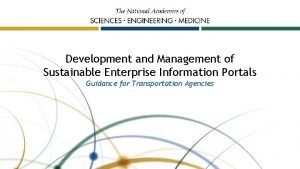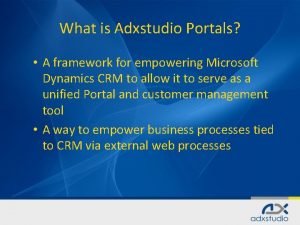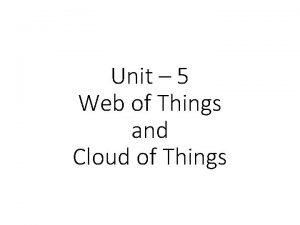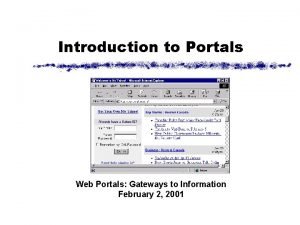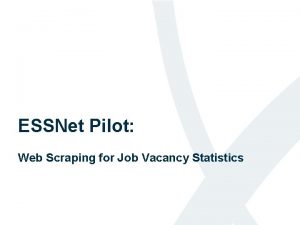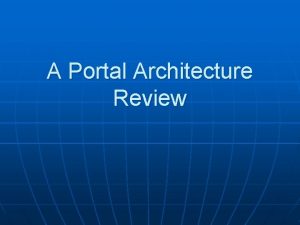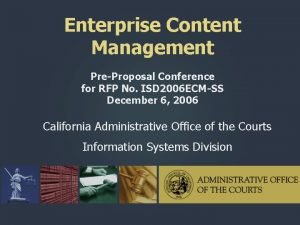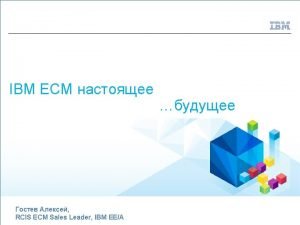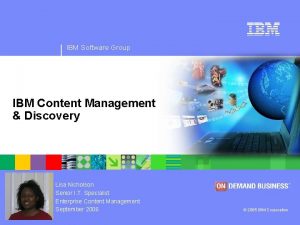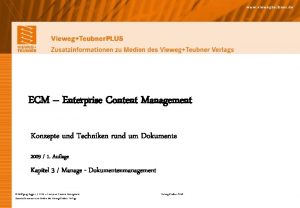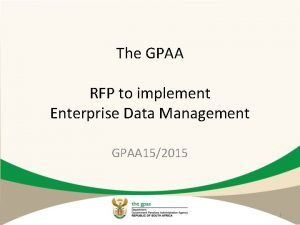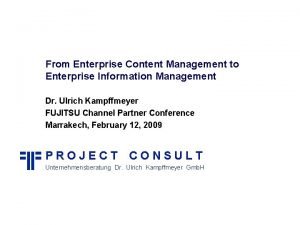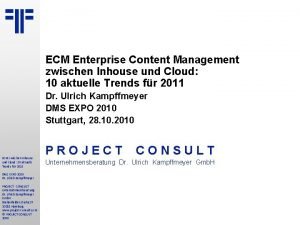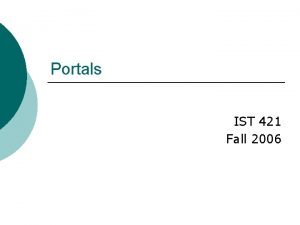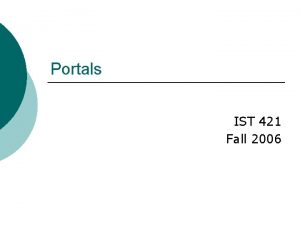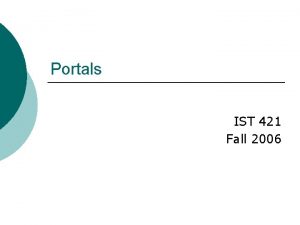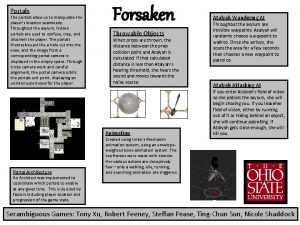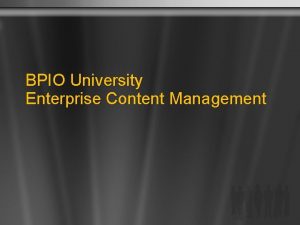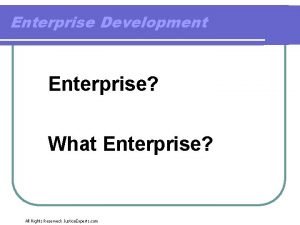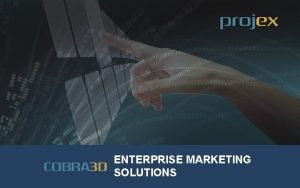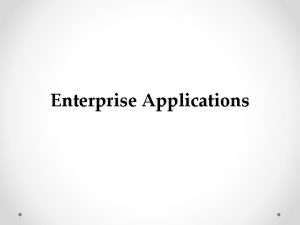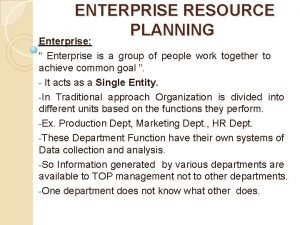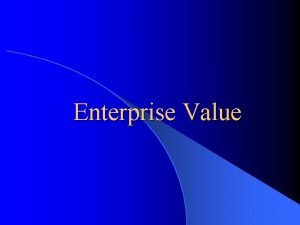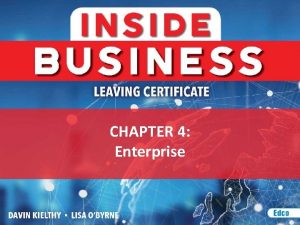CONTENT Introduction of the evolution of enterprise portals






















- Slides: 22

CONTENT: • Introduction of the evolution of enterprise portals. • Definition of the evolution of enterprise portals. • Structured and unstructured data resources. • Integration Using an Enterprise Portal • Enterprise portal categories • Summary

Introduction of the evolution of enterprise portals. • The term enterprise information portal (EIP) was used in a November 16, 1998, Merrill Lynch report. • They commented that EIP systems provide companies with great competitive advantage. • They identified a new category for integration of systems in an EIP—with integrated applications that combine, standardize, index, analyze and distribute targeted, relevant information that end users need to do their day-to-day jobs more efficiently and productively. • They identified benefits that include lowered costs, increased sales, and better deployment of resources.

Definition of the evolution of enterprise portals. An EIP is also called an enterprise portal (EP) or a corporate portal (CP). A single gateway via the network to relevant workflows, application systems, and databases, tailored to the specific job responsibilities of each individual.

Cont… An enterprise portal can appear in different forms, depending on the job responsibilities of each person accessing the portal. For example, an employee portal is defined in this way: A single gateway that enables all employees to access the processes, systems, workflows and databases via the network to carry out their relevant job responsibilities, with full security and firewall protection.

Cont… Another example is a customer portal, defined as follows: A single gateway using the network to details about products and services, catalogs, and order and statement status for customers, tailored to the unique requirements of each customer.

Cont… An enterprise portal that offers personalization and management for the Supply Chain Management (SCM) function is a supplier portal and is defined as follows: A single gateway to the purchase orders and related status information for the suppliers of an enterprise. An enterprise portal as a partner/shareholder portal is similarly “a single gateway for business partners or shareholders. ”

Basic Architecture of an Enterprise Portal • An enterprise portal is a Web-enabled, distributed environment with a single, common, managed user interface to information supporting all categories of end users • It facilitates and supports e-commerce, ebusiness, enterprise resource planning (ERP), CRM, and SCM, along with browserenabled access for customers, suppliers, business partners, and employees

Cont… • A key characteristic of enterprise portals is support of a single sign-on function: enabling qualified users to sign on once to the portal and be automatically signed on to each application or resource that they are authorized to access for relevant sites in the enterprise network

PORTAL

Structured and unstructured data resources. Structured resources: Data warehouses and information systems provide access to structured data in the databases and data files of an enterprise. These data and information resources typically represent only 10% to 30% of the total knowledge resources in most enterprises today.

Cont… • • Unstructured resources: Unstructured data resources exist as documents, reports, email, graphics, images, audio, and video. These unstructured data sources represent the remaining 70% to 90% of the knowledge resources of an enterprise. They are typically inaccessible from data warehouses and information systems. They exist in many different versions scattered throughout the enterprise and in different file formats: Microsoft Word, Excel, Power. Point or Outlook; Adobe Acrobat PDF files ; and different image, graphics, audio, and video formats.

Integration Using an Enterprise Portal • An enterprise portal appears to deliver integration across many data source presented in the separate windows. • An enterprise portal that provides a view to one of these redundant versions sees only those values for the relevant version (update the version). • A portal presents an appearance of integration. • It supports presentation integration. • But the underlying data themselves must first be integrated. Access through a portal to nonintegrated, this is also highly dangerous because the data will appear to be integrated, but are not.

Cont….

Functions Supported by a portal • Authentication server: This is used to define user identify profiles in the portal repository. It maps data, content, and people to a defined user—automatically or contextually. • Security server: This provides support for single sign-on, encryption, and also for various security technologies, such as Kerberos or HTTP/SSL. • Search engine: This server capability supports ad hoc searching across both structured and unstructured data sources, either within or outside the portal.

Functions Supported by a portal. • Content management server: This scans, filters, and catalogs content from disparate data and resources. It often supports Web crawlers on the Internet and intranet. • Business analysis server: This is used for built-in decision support functions, such as ad hoc queries, reports, graphs, analyses, and links to external BI tools. • Connections server: This provides real-time connections to many source data systems, including legacy, ERP, DBMS, e-commerce, e-business, and so forth. • Collaboration Server: This allows users to interact with individuals, groups, teams, and experts to share data and solve problems.

Enterprise Portal Product Categories Enterprise portals comprise three categories: • collaborative portals, • business intelligence portals • integration portals. Portal products are generally categorized based on their predominant focus, but most also offer capabilities in other categories

Collaborative Portal Products • Collaborative portals generally focus on unstructured knowledge resources, and typically offer access to Microsoft Exchange and Lotus Notes. Examples of such resources are documents, reports, e-mail, graphics, images, audio, and video. The Ford B 2 E internal corporate portal and the GM employee portal discussed earlier are examples of collaborative portals. Collaborative portal products include the following: • IBM Web. Sphere Portal from IBM Corporation; • Plumtree Corporate Portal from Plumtree software (now BEA); • Microsoft Share. Point Portal Server from Microsoft Corporation; • Citrix NFuse Elite Portal from Citrix, Inc.

Business Intelligence Portal Products • Business intelligence portals generally focus on structured knowledge resources, with access to data warehouses and information system databases. These structured resources are accessed via business intelligence (BI), online analytical processing (OLAP), and other tools. Most data warehouse products are evolving into this BI portal category. Some representative BI portal products include: • Axielle from Ascential Software (now IBM); • Clever. Path Portal from Computer Associates; • Cognos Upfront from Cognos, Inc. ; • Enterprise Information Portal from Hummingbird

Integration Portal Products • Integration portals focus on easy integration between structured and unstructured knowledge resources existing in information systems and data warehouse databases, ERP environments, CRM, SCM, and others—within an enterprise via the corporate intranet, or between enterprises via the Internet. The Herman Miller B 2 B e-business portal (My. SIGN) discussed earlier is an example of an integration portal. • A popular integration portal product is SAP Enterprise Portal from SAP

Summary of Enterprise Portal Characteristics The general capabilities, features, or facilities of enterprise portals are to • Provide a single point of content delivery and management • Collect and organize information, making it easy to navigate • Provide a customizable, personalized, Webbased user interface

Summary of Enterprise Portal Characteristics • Provide a customizable, personalized, Web-based user interface • Include a content management system that automatically scans, filters, and catalogs content from internal and external sources • Provide a capability to easily publish information and subscribe to information tailored to end users’ specific needs • Include a search engine, content scanner, and Web crawlers to maintain, analyze, and locate information • Utilize a single sign-on for password and authentication, ideally LDAP compliant

Summary of Enterprise Portal Characteristics • Utilize and attach to the native security of the underlying applications • Provide support for and integration of structured and unstructured information • Provide integrated access to an enterprise business intelligence system • Provide access to query and reporting, spreadsheet, graphs, and OLAP functions
 Enterprise information portals
Enterprise information portals Enterprise information portals
Enterprise information portals Carrier content vs real content
Carrier content vs real content Dynamic content vs static content
Dynamic content vs static content Vvais iestāžu portāls
Vvais iestāžu portāls Geisingerconnect
Geisingerconnect Wbte.drcedirect/mi/portals/mi
Wbte.drcedirect/mi/portals/mi Intrusion fantasy examples
Intrusion fantasy examples Mistakes are the portals of discovery
Mistakes are the portals of discovery Types of portals
Types of portals Adxstudio documentation
Adxstudio documentation Wot portals and business intelligence
Wot portals and business intelligence Examples of horizontal portals
Examples of horizontal portals Scraping job portals data
Scraping job portals data Nn model portal
Nn model portal Content management rfp
Content management rfp Ibm ecm cloud
Ibm ecm cloud Ibm enterprise content management
Ibm enterprise content management Ecm wiesbaden
Ecm wiesbaden Data governance rfp
Data governance rfp Open source enterprise content management
Open source enterprise content management Enterprise information management definition
Enterprise information management definition Enterprise content management definition
Enterprise content management definition

